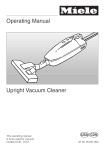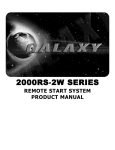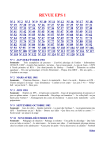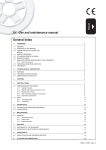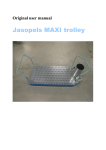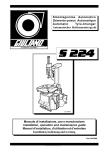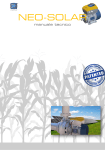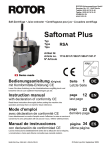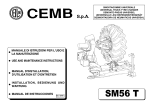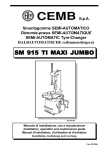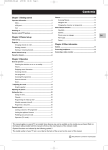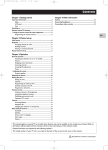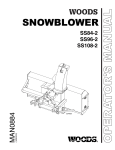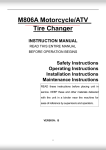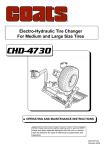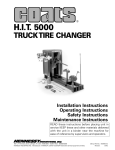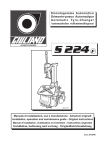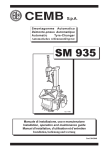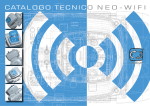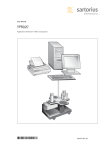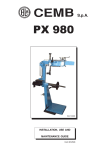Download User Manual
Transcript
Operation Instructions Original Instructions Ed.10/13 Cod. 3019988 English MATIC 750 EC DECLARATION OF CONFORMITY CEMB S.p.a. - Via Risorgimento, 9 - 23826 Mandello del Lario (LC) - ITALY do hereby declare on our own responsibility that the product: Passenger Car Tyre Changer Crossage EVO which this statement refers to meets the following directive 86/217/CEE - 2006/42/CE 2006/95/CE - 2004/108/CE EN 12100 - EN 60204-1 as well as the following: The signature of this declaration of conformity is the person authorised to provide for the technical literature file. Mandello del Lario, 14/06/12 The model of the present declaration complies with directive EN ISO / IEC 17050-1 ROHS DECLARATION OF CONFORMITY CEMB S.p.a. - Via Risorgimento, 9 - 23826 Mandello del Lario (LC) - ITALY do hereby declare on our own responsibility that the product: Passenger Car Tyre Changer which this statement refers to meets the following directive:: 2011/65/EU (RoHS) Scrapping must be made in accordance with the following directive: 2002/96/CE e 2003/108/CE (RAEE) as well as with the national laws in force in the Country of Installation. Mandello del Lario, 14/06/12 Remarks: for all the machines/appliances distributed from 01.01.2006 on, also all non-original spare parts will have to meet the directive 2002/9/C E (RoHS). RAEE DECLARATION OF CONFORMITY CEMB S.p.a. - Via Risorgimento, 9 - 23826 Mandello del Lario (LC) - ITALY do hereby declare on our own responsibility that the product: Passenger Car Tyre Changer which this statement refers to meets the following directive: 2002/96/CE e 2003/108/CE (RAEE) Raccolta differenziata This equipment is subject to the regulations foreseen by Directives 2002/96/CE and 2003/108/CE (RAEE) and therefore it cannot be scrapped as a generic scrap material but through specific collection circuits; the symbol with “barred tank” marked on the product refers to this prescription. Scrapping must be made in accordance with Directives 2002/96/CE and 2003/108/ CE (RAEE) as well as with the local Regulations in force in the Country of installation, the non-respect of the Directive is subject to sanctions according to the national Laws of the Country of destination. Abandonment or wrong scrapping of the equipment subject to Directive 2002/96/CE can cause serious damage to the environment. The manufacturer is available, according to the Directive, to scrap the equipment; for this service, please contact the manufacturer or your dealer. Mandello del Lario, 14/06/12 2 CONTENTS PAGE CHAPTER 1.0 INTRODUCTION......................................................................................................................................................4 1.1 Tyre-Changer data...............................................................................................................4 1.2_DManufacturer data...........................................................................................................................4 1.3_Data plate.............................................................................................................................4 2.0 GENERAL DESCRIPTION....................................................................................................................4 3.0 SPECIFICATIONS.....................................................................................................................................5 4.0 DECALS PLACEMENT..........................................................................................................................................6 5.0 SAFETY INSTRUCTIONS....................................................................................................................7 6.0 SAFETY DEVICES.............................................................................................................................7 7.0 TraNSPORT.........................................................................................................................................................8 8.0 UNPACKING.......................................................................................................................................................8 9.0 InstallaTION....................................................................................................................................................9 9.1_Tyre-Changer site requirements........................................................................................................................9 9.2_PTyre-Changer placement and connections.....................................................................................................9 10.0 EQUIPMENT COMPONENTS...........................................................................................................................10 11.0 CONTROLS DESCRIPTION......................................................................................................................11 12.0 RIM AND TYRE IDENTIFICATION...............................................................................................................12 13.0 VALVE POSITION...............................................................................................................................12 14.0 WHEELS AND TYRES CLASSIFICATION.......................................................................................................13 14.1_Standard wheels.....................................................................................................................................13 14.2_Low-profiled tyre (UHP) wheels.....................................................................................................13 14.3_RUN-FLAT tyre wheels....................................................................................................................13 15.0 WDK RULES................................................................................................................................................13 16.0 POSITIONING AND CENTERING ONTO CENTER PLATE....................................................14 17.0 WHEEL LOCKING..................................................................................................................................15 17.1_Pneumatic locking..........................................................................................................................15 18.0 BEAD LOOSENING.......................................................................................................................................16 18.1_Upper bead..............................................................................................................................................16 18.2_Lower bead.........................................................................................................................................17 19.0 DEMOUNTING LOWER BEAD ON SPECIAL TYRES...................................................................................18 20.0 RIM AND TYRE MATCHING.................................................................................................................................18 21.0 TYRE DEMOUNTING..............................................................................................................................18 21.1_Upper bead demounting....................................................................................................18 21.2_Lower bead demounting.....................................................................................................................20 22.0 TYRE MOUNTING.........................................................................................................................20 22.1_Lower bead mounting............................................................................................................................20 22.2_Upper bead mounting..........................................................................................................................21 22.3_UHP and RUN-FLAT tyres mounting..................................................................................22 23.0 INFLATION.............................................................................................................................................23 24.0 STANDARD ACCESSORIES..................................................................................................24 25.0 OPTIONAL ACCESSORIES.....................................................................................................25 26.0 RE-POSITIONING................................................................................................................................27 27.0 STORAGE......................................................................................................................................27 28.0 SCRAPPING...............................................................................................................................27 29.0 OIL TREATMENT.......................................................................................................................................................27 30.0 MAINTENANCE...............................................................................................................................................28 30.1_Standard maintenance............................................................................................................28 30.2_Extraordinary maintenance............................................................................................28 31.0 TROUBLESHOOTING CHART............................................................................................29 32.0 WIRING DIAGRAMS...........................................................................................................................31 33.0 PNEUMATIC DIAGRAMS..........................................................................................................................32 34.0 SERVICE REPORTS................................................................................................................................34 3 1.0 INTRODUCTION Thank you for purchasing one of our Professional Tyre-Changer designed for demounting and mounting operations on standard, UHP and “run-flat” tyres. To prevent accidents or damages to the tyre-changer, use only recommended procedures and accessories. 1.1 Tyre-Changer data: Please refer to “Tyre-Changer Model” and “Serial Number” data on the Data-Plate (see sample below) to provide our Technical Service Dept. with the necessary details for prompt assistance and spare-parts tracking. In case of discrepancies between Tyre-Changer data on Data-Plate and this Manual, please refer to Tyre-Changer dataplate only. 1.2 Manufacturer data: Please check the “Declarations of Conformity” at page 2 of this Manual and Tyre-Changer Data-Plate 1.3 Data-plate: LOGO Model 2.0 GENERAL DESCRIPTION The Tyre-Changer is intended for mounting and demounting most tyres with alloy or steel rim diameter from 12” to 30” and standard, Run-Flat and UHP tyres with maximum diameter of 1.200 mm (47”). The Tyre-Changer is NOT intended for demounting completely- or partially-inflated tyres, dirty tyres, nor for rim bending or industrial wheels with split ring rims demounting. All these operations are forbidden. This Manual is part of this Tyre-Changer. Use equipment only as described in this Manual. Read and understand all instructions before operating this machine. Keep this Manual in good conditions for further references. Keep all instructions permanently with the unit. 4 3.0 SPECIFICATIONS Connections: -Electrical Feeding: 400V - 3Ph - 50/60 Hz (230V - 1Ph - 50/60 Hz motoinverter) -Working air pressure: 8÷10 bar (116÷145 psi) -Air-feeding pressure regulator set at 10 bar (145 psi) included -Inflating air-pressure regulator set at 3,5 bar (50 psi) included Working capacity: -Rim diameter clamping: 10” to 34” -Maximum rim width: 16” (410 mm) -Maximum wheel diameter: 47” (1200 mm) Motoinverter chuck details: -Motor power: 0,75 Kw -Maximum torque: 1200 Nm -Clockwise rotation speed: 6÷12 rpm -Working noise level: < 70 dB Bead-Breaking units: -Rollers BB cylinders power at 10 bar: 11770 N (1200 kg) -Rollers BB maximum span: 670 mm (26”) -Bead-pressing cylinder power at 10bar: 4218 N (430 kg) Layout details: -Minimum overall dimensions mm: 1180 x 1300 x 1770 H -Net weight (optional accessories excluded): 425 kg -Operating temperature range: min +5° C max +50° C (+41°÷+122° F) Standard accessories (ref. page 24): -WDK clamp with rubber protections -Kit of plastic inserts for mounting tool -Plastic lever -Plastic protections for centering cone -Rubber protections for chuck -Plastic protections for chuck dowel -Step-down ring -Plastic protections for rim Main optional accessories (ref. page 25): -Inflating device for tubeless wheels -FPM 456 flange for rims with reversed groove, blind wheels and special wheels -Centering cones for LCVs rims 1130 2120 Packing details Overall dimensions (mm) Carton 1860 Gross weight 455 kg (without optional accessories) 8 19 60 Wooden pallet 11 3 118 5 5 4.0 DECALS PLACEMENT Cod. 3033099 Cod. 3035727 Cod. 3033101 Cod.3005411 Cod. 3005416 Cod. 3019742 Cod. 3019739 Cod. 3033102 Cod. 3005742 Cod. 3033098 Cod. 3033097 Cod. 3033095 Cod. 3033096 Cod. 3008944 Cod. 3005410 Cod. 3001104 Cod. 3036268 Cod. 3000048 Cod. 3005414 Cod. 3019736 Cod. 3038028 Cod. 3038051 ATTENZIONE! Replace any warning label immediately in case of damage or loss. Do not operate the Tyre Changer in case of warning labels lack. Do not hide any warning label by any mean. Refer to the above mentioned codes for warning labels ordering. 6 5.0 SAFETY INSTRUCTIONS The Tyre-Changer has to be used by qualified and authorised personnel only. A qualified operator is someone who has fully understood the instructions described in the operation instructions manual supplied by the manufacturer, who has been specifically trained and who is aware of safety standards at the workplace. It is essential to use proper service methods and change tyres in an appropriate and acceptable manner that does not endanger your safety, the safety of others in the work of area or the equipment or vehicle in a safe manner. It is assumed that, prior to using the Tyre-Changer, the operator has a thorough understanding of the wheels and tyres being changed. In addition, it is assumed he has a thorough knowledge of the operation and safety features of the Tyre-Changer accessories being utilized, and has the proper hand and power tool necessary to service the vehicle in a safe manner. Those in charge of using the machine shall not be under the influence of drugs, alcohol or other substances, which could compromise their physical and mental work capabilities. For greater safety, operators shall wear health & safety footwear, gloves, protection goggles and shall NOT wear any form of clothing that could get caught up or restrict the operator’s movements. The operator must be able to: - read and ensure full comprehension of the use and maintenance manual to be able to use the machine correctly and safely. - read and understand the danger warnings. - understand the characteristics of the machine. - keep unauthorised people away from the work area. - make sure the machine is started in full observance of all the applicable safety standards and rules. - make sure all operators are familiar with the machine and how to use it safely and correctly. - avoid touching moving parts or pressurised parts without first disconnecting the machine from the electrical and air power supply. - keep the operation instruction manual with care in an easily accessible place, so that it can be consulted whenever needed. The Tyre-Changer may exclusively be used by expert, specifically trained and authorised personnel only. - The use of the machine is forbidden to disabled operators if their disabilities may affect the safety of the working operations - Tampering or modifications to the equipment that are not authorised in advance by the manufacturer, relieve the lat ter from all forms of liability as regards to damages deriving from or referable to such actions. - Removal or tampering with the safety devices provides grounds to immediately cancel the warranty and involves violation of European Safety Regulations and codes. - The Tyre-Changer is equipped with informative and warning decals, which are designed and produced to last in time. If they should deteriorate, user may request replacement decals. IN CASE OF FIRE, USE ONLY DRY CHEMICHAL OR CO2 EXTINGUISHERS TO PUT THE FIRE OUT. WATER extinguisher FOAM extinguisher POWDER extinguisher CO2 extinguisher DRY materials FLAMMABLE liquids OK NO ELECTRICAL equipment NO OK OK OK OK OK OK NO OK OK 6.0 SAFETY DEVICES This Tyre-Changer is provided with the following safety devices in order to grant the operator’s safety. -Pressure limit valve, installed into the Tyre-Changer to avoid inflations over 3,5 bar (50 psi) pressure. -Pressure regulator with manometer, to limit the maximum system pressure to 10 bar (145 psi). -(on Tyre-Changers equipped with “TubeLess inflating device”) Limit Valve, installed onto the air tank to avoid exceeding 11 bar (160 psi) pressure value. Removing or tampering with safety devices immediately invalidates the guarantee and it is in contravention of European Safety Rules. 7 7.0 TRANSPORT The Tyre-Changer must be transported in its original packaging The packaged machine has to be moved by mean of a fork lift of suitable capacity (500 kg min.). Please, insert the forks as shown by the following picture “fig. 1”. 8.0 UNPACKING Remove the protective cardboard, remove all fixing screw and free the Tyre-Changer from its original pallet. Check the perfect condition of the machine, making sure that no part is damaged or missing, referring to the picture at page 10. If in doubt, please do not use the machine and get in touch with your Distributor for further steps. Keep packing elements away from children. All packing elements must be stored in the proper stocking areas. Note: All the most delicate surfaces of the Tyre-Changer are coated by a special rust-proof oil. Some oil traces may leak after coating procedure: please, remove them accordingly. Gross weigth 455 Kg. fig. 1 Lifting point fig. 2 After tyre-Changer positioning, take of the lifting belt. The machine must be moved by means of suitable capacity (fork-lift: 500 kg min. as per “fig. 1” or crane with liftingbelt: 500 kg min. as per “fig. 2”). Lifting point After having positioned the machine, in its final location, release the safety pin against accidental tilting of the arm (fig. 3) Put the pin together with the other standard accessories delivered with the machine, for any future need. Fig. 3 8 9.0 INSTALLATION 9.1 Tyre-Changer site requirements When choosing the place of installation be sure that it complies with current safety-at-work regulations. The Tyre-Changer must be connected to the main electric power supply and the compressed air system. It is therefore advisable to install the machine near these power sources. The installation area must leave at least the room shown in picture “fig. 4”, so as to allow all parts of the machine to operate correctly and without any restriction. 1850 Fig. 4 9.2 Tyre-Changer placement and connections Place Tyre-Changer onto a levelled-out, smooth and not slippery floor with a suitable load capacity. No bolt down installation is required. In case of bolt-down installation, please refer to all 4 holes on the base of the machine, drilling through 100 mm into the floor and using suitable bolts for fixing. If the machine is installed outside it must be protected by a appropriate lean-to shed. The electric network of the installation area must be provided with adequate earth plate and connected to an automatic circuit-breaker (differential) set at 16 mA. Should the Tyre-Changer be lacking in electric plug, the user must set one - at least 16 A and conform to the voltage of the machine, in compliance with the regulations in force. Before connecting the machine, please check that the characteristics of your networks correspond to those indicated by machine’s data-label. Even small jobs done on the electrical system must be carried out by professionally qualified personnel. The Manufacturer is not responsible for damages caused by electrical connection different from the original indications. Unplug the unit from electrical and pneumatic outlets before moving and servicing. The pneumatic network of the installation area must be provided with min. 8 bar working pressure outlet. Connect the machine to the pneumatic network by means of the air fitting on oiler filter/ regulator installed onto the rear section of the machine. 9 10.0 EQUIPMENT COMPONENTS Leverless mouinting/demounting system QX TubeLess inflating unit (optional) cod. 9236665 Inflating unit with pressure gauge and pneumatic locking Roller bead loosening control unit Press Arm Roller bead loosening unit Locking nut Center plate Wheel positioning device (optional) cod. 9237720 Pedal control units 10 11.0 controls description 6 14 20 22 23 7 8 9 10 11 13 12 19 16 17 21 15 5 18 4 1 3 2 1-Tilting pole pedal control 14-Deflation button (inflating: by pedal 4) 2-Clockwise and anticlockwise centre plate (ref. 15) rota- 15-Center plate tion pedal control 16-Upper bead loosener roller 3-Wheel positioning device control pedal (optional) 17-Press arm control switch 4-Inflation pedal control 18-Lower bead loosener roller 5-Bead loosening rollers override engaging button 19-Operating arm control button 6-Bead loosener locking and override (ref. 5) activation 20-QX leverless system control switch switch. 21-Upper bead loosener tilting control 7-Bead loosener releasing button. 22-Center plate pneumatic locking switch 8-Bead loosener “forward” movement button 23-Handle for disengagement of the Lever-Less mounting tool 9- Bead loosener “back” movement button 10-Upper bead loosening roller lifting button 11-Upper bead loosening roller lowering button 12-Lower bead loosening roller lowering button 13-Lower bead loosening roller lifting button Any test must be operated with no tyre onto the machine. Mind any component which could interfere with machine testing operations. 11 12.0 RIM AND TYRE IDENTIFICATION Before starting demounting a tyre, it is of CRUCIAL IMPORTANCE to identify the measurements of the rim and of the tyre, as well as to make sure that neither the rim nor the tyre are damaged. Warning: these very important procedures have to be correctly performed to reduce risks of tyre bursting while re-mounting and inflating the tyre on the rim. Each rim bears an indication of their diameter, width, number of humps etc. Example: 8Jx15H2 A = 8 nominal width of the rim in inches (1 inch= 25.4 mm) B = J size of the flange B C = 15 nominal diameter of the rim C A D = H2 double hump (anti bead removing edge) D 8J x 15H2 Each tyre bears a considerable amount of details, among which are the dimensions, type and maximum speed. Example: 205/65 R 15 91H TL A B C D EF G A = 205 width of the tyre (the distance between tyre sides, expressed in millimetres) B = 65 ratio percentage between the height of the section and its width C = R type of tyre (R= radial) D = 15 keying diameter(diameter of wheel and rim) in inches E = 91 index of the maximum load born by each wheel F = H maximum admitted speed of the tyre (H= 210 Km/h) G = TL type of tyre (T= Tubeless) 13.0 VALVE POSITION The picture on the right side symbolizes a rim as a clock face. The valve positions described by the following working steps always refer to the represented clock-face hours-marks. Mind the position indications (hour-marks) in order to put the valve and the pressure-sensor in correct and safe positions. It is strictly forbidden to mount tyres on rims with mismatching parameters (diameter and width). It is also forbidden to mount tyres with dimensions which are different from the ones stated in the car logbook. 12 14.0 TYRE CLASSIFICATION 14.1 Standard wheels A “standard wheel” is a car wheel with steel or alloy rim, with center hole, drop centre close to the external border of the rim and a standard tyre (not RUN-FLAT nor LowProfile). 14.2 Low-profiled tyres (UHP) wheels Low profile tyres (UHP) are those in which the height (H) and the width (C) have a ratio lower than 0.5 (i.e. low profile series 45 stands for a ratio of H/C = 0.45). For tyres to be considered as low profile (UHP), they must also have a maximum speed code of equal to and/or higher than V. Maximum speed codes Q= to 160 km/h R= to 170 km/h S= to 180 km/h T= to 190 km/h U= to 200 km/h H= to 210 km/h V= to 240 km/h W= to 270 km/h ZR= > 240 km/h ZR(Y)= > 300 km/h 14.3 RUN-FLAT tyres wheels RUN-FLAT tyres are those which allow to continue to drive the vehicle for a preset number of miles and at a preset speed, even if they have no internal pressure. These parameters change from one manufacturer to another. The market currently offers 2 different types of RUN-FLAT tyres: - Those with reinforced sidewall (self-supporting) where, thanks to a different mix and a reinforced structure, the shoulder of the tyre can bear the weight of the vehicle even when the internal pressure of the tyre is zero. - Those with internal support which have a ring inside the rim that bears the sidewall of the tyre when there is no pressure inside it. The internal support may be made of plastic (Pax-Sistem) or of metal (Support-Ring). All the tyres which do not correspond to the above mentioned descriptions have to be considered as “standard tyres”. This Tyre-Changer is able to handle all types of wheels with “standard” tyres, LowProfile (UHP) and RUN-FLAT tyres with reinforced side. RUN-FLAT tyres with internal support (PAX System or Support-Ring type) mounting/demounting procedures need special accessories to be used according precise dedicated instructions. The mounting and demounting procedure is similar with “standard” tyre, LowProfile tyre (UHP) tyre or RUN-FLAT tyre with reinforced side (self-supporting). The bead-breaking procedure should be operated by shovel-blade bead-breaker with “standard” wheels – in order to save time – while the rollers bead-breaking unit has to be used for all LowProfile (UHP) and RUN-FLAT tyres. It is compulsory to follow the demounting/mounting instructions carefully, in order to avoid tyre damages and the consequent risks for the vehicle and the passengers safety. 15.0 WDK RULES WDK is a German certified body charged with the evaluation of tyre-changers functioning and their capability to perform good and safe operations on RUN-FLAT and UHP tyres correctly, to avoid permanent and potentially dangerous damages to tyres. In order to perform a correct demounting and mounting process, the following premises are strictly compulsory: 1. Guidelines knowledge - WDK literature provides all necessary guidelines for all tyre brands and models, including all theoretical and practical instructions to avoid any possible damage to tyre, rim and pressure sensor. 2. Certified tyre-changer - This Tyre-Changer is WDK certified and fulfils all WDK requirements. 3. Qualified operator – The specific technical courses provide the operators with the necessary WDK guidelines and service instructions. Dedicated WDK official courses are available to get the WDK diploma, when necessary. 13 16.0 WHEEL LIFTING AND CENTERING ONTO CENTER-PLATE Before lifting and positioning the wheel onto the centre-plate, please: - remove all weights from the rim by a proper tool carefully, - remove any object or tool which could interfere with lifting. -Put the wheel vertically onto the optional wheel positioning device (rim back facing the Tyre-Changer) -Press the control pedal ref. 3 to lift the wheel-positioning device. Once the wheel is over the centre-plate, align the wheel central hole to the centre-plate central hole. -Release the control pedal fef. 3 to lower the wheel positioning device. Rotate the wheel in order to make one fixing hole of the rim match with the driving pin of the centre-plate. Wheel positionig device (optional) 3 Driving pin Centre-plate Wheel positionig device control pedal 14 17.0 WHEEL LOCKING 1. 2. 3. 4. Insert the ring nut hub correctly (the cone plastic cover preserving the alloy rims from damages) Turn the ring nut hub clockwise by hand until you find the exact coupling position, then press the hub and turn it clockwise by 90° to its full-stroke Release the ring nut and make sure it raises by 0,40° (10 mm) approximately, otherwise turn it slightly clockwise or counter-clockwise lifting up the hub. Make sure the plastic cone is in contact with the rim, perfectly centred with the drop-centre hole, the split of the nose matching up with the driving pin. Tighten the ring nut so that it moves up to the cones and continue tightening so that the wheel is pushed firmly on the flange of the spindle. 17.1 Pneumatic locking system (optional) If the tyre-changer is provided with the optional pneumatic locking system: 1. 2. 3. 4. Insert the ring nut hub correctly (the cone plastic cover preserving the alloy rims from damages). Turn the ring nut clockwise by hand until the exact coupling position, press the ring nut until its end-stroke and rotate the ring nut hub 90° by hand. Release the ring nut and make sure thet it raises by 0,40° (10 mm) approximately. Rotate the pneumatic locking switch onto the manometer panel to the locking position. 4 Make sure that rim is perfectly locked onto the cente-plate before starting any operation on the wheel 15 18.0 BEAD LOOSENING Make sure the tyre is completely deflated before starting any operation on the wheel. -Remove all weights from the rim by a proper tool, paying attention not to damage the rim. -Before starting any operation, please check the eventual presence of a pressure sensor. In positive case, it is prefe rable to check its efficiency by a dedicated diagnostic tool. -The bead loosening rollers are mounted on special ttilting supports to ease bead loosening on wheels with high profile or soft tyres. This procedure is “Over Run” “OVER RUN” PROCEDURE SHOULD NOT BE USED ON UHP AND RUN FLAT TIRES Push down the hook lever to release the upper roller Lift up the hook lever to release the lower roller. 18.1 Upper bead loosening Check the correct centering and locking of the wheel onto the centre-plate. Check that the upper disk arm is in the right position (step 1) -to move the upper disk in its right position: unlock it from rest position by pressing the right lever to the left (A), then lift the disk arm support by hand and lock it by pressing the right lever to the right (B) Turn the switch 6 clockwise to free the bead-breaking unit and position it by handling the console, in order to let the upper roller keep to 5 mm distance from the rim border, then lock the bead-breaking until by turning again te switch 6 clockwise. Move the bead breaking arm onto the tyre by pressing buttons 8-9 an 10-11 Step 1 4 1 A B 7 6 8 9 10 11 12 13 Pay attention to the valve sensor position during bead loosening steps. Wrong movements of the upper roller could damage the sensor. Avoid contacts between the lubricating paste and the valve sensor, if any. 16 5 3 2 - Spin the centre-plate until the valve reaches position at “3 o’clock” position. - Lower the bead loosening roller until it touches the tyre using controls 9 for lowering and 8 for lifting. - Start spinning clockwise pressing pedal 22. Note: the centre-plate can spin at 2 different speeds, according to operator’s preferences - While spinning the wheel, push the bead loosening upper roller down under the edge of the rim, then press and hold down the “over-stroke” function button 5 going on lowering the roller until the bead detaches from the rim. - As soon as enough space is available, grease both inner surface of the rim and tyre bead carefully with a proper tyre lubricating paste. Fase 2 Avoid contacts between the lubricating paste and the valve sensor, if any. - Once the bead gets loosened, raise and move away the upper roller by acting on button 10. 18.2 Lower bead Keep the bead-loosening unit set up as for upper bead release: the lower roller is always aligned with the upper one, at 5 mm distance from rim lower border already. Lift the lower roller until it touches the lower bead using controls 13 for lifting and 12 for lowering. Start spinning the wheel anticlockwise by pressing pedal 2. - While spinning the wheel, push the lower roller up over the edge of the rim, then press and hold down the “over-stroke” function button 5 going on lifting the roller until the bead detaches from the rim. - As soon as enough space is available, grease both inner surface of the rim and tyre bead carefully with a proper tyre lubricating paste. Fase 3 Note: for a better control of the lower bead loosening please refer to the dedicated mirror fitted onto the Tyre-Changer main frame. Press on the bead – never on the sidewall of the tyre while loosening the bead. 17 19.0 LOWER BEAD DEMOUNTING ON SPECIAL WHEELS The lower bead of reverse drop centre rims with significant width may be hard to break with the lower disk. In this case it is possible to use the upper bead-breaking disk to break the lower bead of the tyre: -tilt down the upper disk arm support to its lower position (step 1) to get both upper-and lower-bead loosening disks at the same tilt-angle (step 2); -follow instructions as per chapter “18 BEAD LOOSENING” at page 16. Step 1 Step 2 Upper bead loosening arm B A Lower bead loosening arm 20.0 RIM AND TYRE MATCHING Driving could be affected by vibrations caused by deformations of the rim and/or of the tyre. To optimize the wheel-balancing, it is necessary to position the wheel onto the Tyre-Changer again to bead-break and lubricate the rim and the tyre, spinning the tyre around the rim to a proper position. Both upper and lower rollers make this process easier, by gently holding the tyre steady while the centre-plate spins the rim until the correct matching position. 21.0 TYRE DEMOUNTING Once the bead loosening process is completed, and the wheel is already positioned onto the center-plate, check and ensure its locking and centering. 21.1 Upper bead demounting Mounting tool in working position 10 cm - Turn the wheel until the valve is in the “1 o’clock” position (roughly 10 cm - 4” distance from the mounting tool) in order to avoid possible damages to the valve or the pressure sensor. 4 1 3 2 Valve 18 -Press the pedal ref. 1 to position the mounting arm close to the wheel while driving. The mounting arm by handling (fig. 5), lock it in position 1 by ref. 19 (fig. 5B) to lock the operating arm and the horizontal arm at the same time. Automatically the mounting tool is moved up and away from the rim border to have a clearance of approx. 2 mm when locked - Lower the lever ref. 20 to insert the mounting tool between the bead and the rim edge. The mounting tool should penetrate enough to hook the tyre bead to let the operator complete the tyre demounting: spin slowly the wheel until the mounting tool is positioned correctly. A gentle pressure on the tyre sidewall by the upper roller could help the mounting tool positioning. Fig. 5B Fig. 5 19 19 Pos. 1 19 Pos. 2 Pos. 3 - As soon as the bead is perfectly hooked, lift the mounting tool by raising lever ref. 20 to pull out the bead. To make the lifting easier set the tyre pressing unit at “6 o’clock” position and press the tyre side (fig. 6). Get a further help by contemporarily lifting the lower tyre side by the lower bead-loosening roller (fig. 7). 20 Fig. 7 Fig. 6 - Press down on pedal ref. 2 to rotate the wheel clockwise until the entire bead is lifted from the rim NOTE: rim and tyre must spin together as one. - In order to help the bead coming out and reduce the stress to the tyre: insert the plastic lever (as shown by picture aside) and spin the wheel clockwise while lifting the tyre by the lower bead-loosening roller. NOTE: The above mentioned action is compulsory for UHP and RUN-FLAT tyres according to WDK rules. To avoid damaging the valve and/or the pressure sensor, move the same to the “1 o’clock” position before inserting the tool in the dropp centre, operating the control lever 20. 19 21.2 Lower bead demounting - Before pulling out the lower bead, spin the wheel to let the valve reach “1” or “2” o’clock position in order to avoid possible damages to the valve and the sensor - if any. - Lower the lever ref. 20 to insert the demounting tool under the lower bead. Raise the lever ref. 20 to lift the demounting tool and the bead. - Raise the lower bead loosening roller to lift the tyre until the lower bead is 1 cm over the upper rim edge. - In order to help the above mentioned operation, lift the tyre manually at “2” or “3” o’clock position and insert the plastic lever as per WDK rules for UHP and RUN-FLAT tyres. - Spin the wheel clockwise until the tyre complete coming out. - Press the pedal ref. 1 to move the mounting arm away, push the rollers bead breaking unit away and pull out the tyre. - Check the status of the pressure sensor - if any - and replace it if necessary. 1 21.3 Tyre demounting by hand lever (LNL Lever-no lever system) 4 3 2 The Tyre-Changer is provided with a patented system which allows the use of a standard steel lever to demount special wheels as: - Wheels with very narrow rims, - Wheels with very tender tyre sidewalls, - Motorcycle wheels The above wheels can not easily - or not at all demounted with the standard LeverLess system. In order to demount a tyre manually by a standard lever: - pull the retractable claw up away from working area by lifting the handle ref. 23; up (fig. 1). - lean the manual lever onto the fixed claw (fig. 2). 23 Handle Fig. 1 Fig. 2 Retractable claw Fixed claw Once the manual demounting is finished, the standard position of the retractable claw can be restored by lowering the handle ref. 23.. 20 22.0 TYRE MOUNTING - Check the rim and the tyre carefully, as per instructions at page 12 of this manual. - If the rim has been moved, lock it again onto the centre-plate as per instructions at page 16 of this manual. - Lube 3 cm thickness along the whole internal surface of the rim and internal and external surface of tyre beads. Avoid contacts between the lubricating paste and the valve sensor, if any. 22.1 Lower bead mounting - Put the tyre onto the centre-plate tilting the tyre at “12 o’clock” position in order to make both upper and lower beads go under the upper rim edge. - Press pedal ref. 1 to approach the mounting arm and position the mount/demount head onto rim edge. - Incline the tyre to the bottom at “3 o’clock” position, driving the lower bead to the mounting head in order to put the lower bead over the mounting lip on the left side of the head and under the demounting claw on the right side of the head. - Rotate the wheel by pressing the pedal ref. 2, contemporarily press the tyre at “5 o’clock” position until the bead reaches the drop centre level. Keep the tyre pressed until “8 o’clock” position while rotating to complete the lower bead mounting. 22.2 Upper bead mounting - Keep the mounting arm and the mount/demount head at working position, then put the tyre bead on the rim slightly tilted down to “3 o’clock” position.. Bead correctly positioned over the mounting lip. OK Bead correctly positioned under the demounting claw OK Bead incorrectly positioned causing bead damages between the head lip and the rim edge Bead incorrectly positioned - Press the button ref. 11 to lower the upper bead loosening roller until the upper bead reaches 3 cm level under the rim edge. - Make sure that the upper bead of the tyre rests on the left lip of the head and under the demountig claw on the right side of the head. - Press the pedal ref. 2 to rotate the wheel clockwise, contemporarily press the tyre manually from “5 o’clock” position to force the bead at drop-centre position. Keep it pressed while rotating up to “8 o’clock” position to complete the upper bead mounting. Make sure that rim and tyre always spin together. - To make the upper bead mounting easier, use the tyre pressing unit by setting it at “5 o’clock” position and pressing lever ref. 17 to keep the bead at drop-centre level while rotating up to “8 o’clock” position until the tyre complete mounting. 21 17 22.3 UHP and RUN-FLAT tyres mounting - Some precise and careful operations are necessary to mount UHP and RUNFLAT tyres. It is compulsory to follow WDK rules to avoid permanent damages to these tyres. -Lower bead mounting can be performed as per standard instruction at page 20 of this manual.. -Once the lower bead is mounted, keep the mounting arm and tool at working position and start WDK upper bead mounting procedure putting the tyre slightly tilted down to “3 o’clock” position. -Use the bead pressing clamp together with the proper rubber protection ( • steel rim, •• alloy rim,••• convex alloy rim) locking the clamp onto rim edge with the valve at “3 o’clock” position. If necessary, press the tyre side by the upper bead loosening roller to help the correct positioning and locking of the clamp (fig. 1). Fig. 1 -Keep the upper bead loosening roller at drop-centre level, spin slightly to insert the pressing tool between the roller and the clamp and pressing onto the tyre side until the upper bead reaches drop-centre level (fig. 2). -Make sure that the upper bead of the tyre rests on the left lip of the mount head and under the demounting claw on the right side of the head. -Start spinning the wheel paying attention to the bead not going between the rim edge and the bead loosening roller. Fig. 2 While spinning, when clamp is roughly at “6 o’clock” position make sure that the whole bead within this section is right inside the drop-centre. -If this necessary condition for a correct mounting is not accomplished, use the bead pressing unit pushing its tool onto the tyre side to insert the bead into the drop-centre (fig. 3). Act gently onto tyre sidewall during the above mentioned process - Go on spinning the wheel until the upper bead is completely mounted. - Remove the clamp and the rubber protection by the help of the pressing unit. Pull the pressing tool away and lift the roller away from the working position by acting on button 10. Press button 7 to move the bead sloosener from working position. - Press the pedal ref. 1 to push the mounting arm up and move the roller bead breaking unit away from working position. - Keep the wheel locked onto the centre-plate during the inflating operations. Read the inflating instructions at page 23 carefully. - Once the tyre inflation is completed, unlock the wheel and bring it down onto the floor, taking advantage of the optional wheel positioning unit. 22 Fig. 3 23.0 INFLATION Tyres must be inflated with the utmost caution. The instructions below have to be read and followed strictly. This Tyre-Changer is not projected to protect operators and objects from accidental tyres explosions. If tyre bead fails to fit in place at 3.3 bar pressure, it is necessary to repeat the bead loosening and lubricating procedures before trying again to inflate the tyre. If the tyre should burst or the rim should break under pressure, operators could be seriously injured or even killed. Make sure the rim and the tyre are the same size. Also check the state of wear of the tyre and the rim to make sure there are no defects before starting to inflate. Inflate the tyre with short blasts of air and check the pressure frequently while inflating. This Tyre-Changer is automatically limited to an inflation pressure of 3,5 bar (50 psi). The pressure regulator is NOT a safety device preventing explosions risks and damages. NEVER EXCEED THE PRESSURE RECOMMENDED BY THE TYRE MANUFACTURER . Keep hands and body as far away as possible from the tyre during inflation. Pressure gauge Inflating pedal 4 Deflation button - Connect the inflation hose to the valve of the tyre. - Make sure the rim and the tyre have the same diameter. - Make sure the rim and tyre are sufficiently lubricated; lubricate if necessary. - Press and release the inflation pedal ref. 4 continuously, checking the pressure on the gauge frequently until the tyre bead fits completely on the rim. - Continue inflating to reach the pressure recommended by the tyre manufacturer. Always inflate in short blasts and always checking the pressure while doing so. - Press the deflation button to deflate the tyre if, during inflation, the pressure exceeds the value recommended by the tyre manufacturer. NOTE: Sometimes, even blowing air into the tubeless tyre it may not inflate. This problem may be solved by using the optional accessory TUBELESS INFLATING DEVICE - In order to use the optional Tubeless Inflating Device: press the safety valve against the rim border, push the activating button onto the handle to blast air and press the inflating pedal ref. 4 in order to feed the wheel valve. - As soon as the tyre beading is completed, store the Inflating Device into its housing. 23 Activating button Safety valve 24.0 STANDARD ACCESSORIES Plastic bead pressing clamp with extra plug for alloy rims with slippery edge. To be used together with rubber protections for mounting UHP and RUN-FLAT tyre according to WDK rules. Rubber protection for steel rims (marked with • ) Rubber protection for alloy rims (marked with •• ) Rubber protection for alloy convex rims (marked with ••• ) Plastic lever. To be used during tyre demounting according to WDK rules. X2 Plastic protections for tool head. X2 X2 X2 Centering cone plastic protection. Centre-plate rubber protection. Driving pin plastic protection. Reduction ring for centre-plate. To be used to fit particular alloy rims. Rim edge plastic protection 24 25.0 Accessori Optional FPM 456 Clamping adaptor for reverse rims, rims without centre hole, BMWrims. Suitable to lock any rim /with any holes-number onto the centre-plate. Reverse rims Rims without centre-holes Art. 455/08 Centering cones adaptor kit for light-truck rims locking (centre hole: Ø120 to Ø190 mm). Art.458/08 Centering cones adaptor kit for light-truck rims locking (centre hole: Ø190 to Ø220 mm). Art. 611/11 Centering conical adaptor for steel rims locking (centre hole: Ø75 to Ø120 mm). Art. 659/11 Two-sides centering conical adaptor for steel rims locking (centre hole: Ø75 to Ø145 mm). 25 BMW rims 9237720 Wheel positioning device Art. 735/12 Tubeless tyres inflating device. 26 26.0 RE-POSITIONING To re-position the Tyre-Changer in a new workplace: secure the moving parts (i.e. the bead pressing arms, etc.) disconnect all the power sources and install it again following all the instruction per chapter 9.0 of this manual. Connections to power sources and connection & inspections of the safety systems must be carried out by trained personnel. 27.0 STORAGE If the tyre changer has to be stored away for extended periods of time: - Disconnect the power sources. - Empty the tanks containing operational fluids. - Protect parts that could be damaged if dust should settle on them. - Grease parts that could damage if they should dry up. When re-commissioning the tyre changer: - Follow the instructions given in chapter 9.0 of this manual. - Replace any damaged parts, referring to the spare parts list - this to be carried out by skilled personnel. 28.0 SCRAPPING If you should decide that the tyre changer can no longer be used, you are recommended to make it unusable by removing the power supply connections, emptying the tanks and disposing of the fluids pursuant to current state and National regulation. The tyre changer is considered as heterogeneous waste and must consequently be split-up into parts made of similar material (electrical parts, plastic parts and ferrous parts), which must be disposed of properly, according to current National regulation. WARNING: follow RAEE and ROHS Conformity Declaration rules for a correct disposal. 29.0 OIL TREATMENT OIL IS POLLUTANT! DO NOT THROW AWAY OUTDOORS OR POUR ON THE GROUND General precautions - Avoid direct and prolonged contact with skin. - Avoid the formation of oil mists in the air. - Avoid splashing. - Wear appropriate clothing, gloves and goggles to protect against oil splashes. - Do not use greasy rags. - Do not eat or smoke if your hands are soiled with oil. First Aid instructions - If oil is swallowed, do NOT induce vomiting but go immediately to the nearest medical centre with information on the type of oil swallowed. - If oil gets in eyes, rinse abundantly with water until irritation ceases, then go to the nearest medical centre. - If oil comes into contact with skin, rinse abundantly with neutral soap and water. do not use solvents or irritant products. Disposing of used oil Do not throw used oil away outdoors or pour it on the ground. Drain into a suitable container and forward to specialised oil disposal centres, or hand it over to authorised collection companies.. Oil spillages or leakages Eliminate the cause of the leakage and stop the oil spillage from spreading using absorbent material. Clean the area where the oil has spilled using degreasing detergents to prevent slipping and dispose of the waste according to current state and Federal regulations. Clean up the oil and send to special disposal centres according to current National regulations. 27 30.0 MAintenance 30.1 Standard Maintenance Routine maintenance according to the following instructions is of crucial importance to ensure the correct operation and lasting life of the Tyre-Changer. Before starting any maintenance job, disconnect the electrical power supply by unplugging the machine from the main electrical feeding and disconnect it from the pneumatic supply by shutting off the valve. To release the compressed air from the circuit, press the inflation pedal (ref. 3) down for a few seconds. On daily basis, keep the machine clean eliminating any mould and dirt to ensure the perfect movement of the slides and the tools and to grant the correct functioning of all centering and locking systems. Do not clean with compressed air, which can blast dirt between moving parts. On daily basis, check for worn or damaged plastic and rubber inserts and protections that should be replaced to prevent damages to rims and tyres. Every 2/3 days, check the oil dropping into the cup (1 drop every 4/5 activations of the bead pressing tool or of the bead loosening systems). If necessary, turn the screw on the top of the cup by a screwdriver. On periodical basis, check the oil level which has to keep between MIN and MAX refs. If necessary, unscrew the cup and top-up by adding oil for pneumatic systems in class ISO HG (i.e. ESSO Febis K32; MOBIL Vacouline Oil 1405; KLUBER Airpress 32). For a long lasting correct functioning of the 10bar pressure limit device, ensure that the drain level doesn’t exceed the MAX DRAIN indication Max Drain If necessary, drain the condensation by turning clockwise the drain tap. (keep the pneumatic feeding on to perform this adjustment). On monthly basis, unplug the machine from pneumatic feeding and remove the filter cup to clean it from possible solid impurities. On periodical basis, clean the sliding guides of the bead loosening carriage by naphtha and lube them by oil or proper grease. Perform the same cleaning and lubricating actions on every junction and mechanical sliding. On periodical basis, check the tensioning of centre-plate rotation driving belt. If necessary, use a 13mm wrench to loosen the fixing bolts of the motor support plate, then adjust the belt tension by acting on the tensioning screw and tight the fixing bolts. 30.2 Extraordinary maintenance - Non-routine maintenance must be carried out by factory authorized personnel ONLY. - Defective parts should be exclusively replaced with genuine spare parts by factory authorized service personnel. - After 5 years from installation date, the Tyre-Changer must be serviced in all its main components to grant its correct functioning and the operators safety. The Manufacturer is not responsible for claims due to non-original spare parts or for damages caused by removal and tampering to the safety devices. Removal or tampering with the safety devices (max. pressure valve – pressure regulator) represents a breach of European Regulations for Workplace Safety. 28 31.0 TROUBLESHOOTING CHART PROBLEM CAUSE ISOLUTION Centre-plate does not rotate 1) Missing electrical feeding 2) Power cord missing or not plugged correctly 3) Fuses blown or differential disabled 4) Drive belt loosened or damaged 5) Motor pulley loosened 6) Micro-switches cam-shaft disconnected from pedal 7) Motor damaged or defective 1) Turn power on 2) Check cord or plug in 3) Replace fuses or enable differential 4) Tighten or replace drive belt 5) Tighten pulley by proper screw 6) Reconnect or replace shaft 7) Replace motor Chuck turns at one speed only or in one direction only after pedal is released 1) Foot pedal connection out of adjustment or not installed correctly 2) Micro-switches fixing screws loosened or missing 3) Micro-switch damaged or defective 4) Pedal return spring broken or loosened 1) Adjust foot pedal 2) Check screws tightening or replace screws 3) Replace micro-switch 4) Replace return spring Chuck rotating motor turns at one speed only or in one direction only 1) Micro-switch damaged or defective 2) Micro-switch cable unplugged 3) Motor damaged 4) Motor cables unplugged 1) Replace micro-switch 2) Check and connect microswitch cable 3) Replace motor 4) Check and connect motor cables Chuck rotating motor turns at one speed only or in one direction only 1) Micro-switch damaged or defective 2) Micro-switch cable unplugged 3) Motor damaged 4) Motor cables unplugged 1) Replace micro-switch 2) Check and connect microswitch cable 3) Replace motor 4) Check and connect motor cables Chuck turns but wheel stays still 1) Wheel locking nut not holding 2) Driving pin not holding 1) Secure locking nut correctly 2) Position driving pin correctly Bead loosening unit do not move vertically or move slowly 1) Pneumatic supply missing 2) Control valve broken 3) Pilot valve broken or defective 4) Cylinder seal broken 5) Mufflers obstructed 6) Control valve air hose squeezed 1) Check line pressure 2) Replace control valve 3) Replace pilot valve 4) Replace cylinder seal 5) Clean or replace muffler 6) Check or replace air hose Bead loosening rollers reach working position but do not perform overrun movement 1) Pneumatic supply missing 2) Control valve broken or defective 3) Cylinder seals broken 4) Overrun pilot valve broken 5) Pilot valve broken or defective 1) Check line pressure 2) Replace control valve 3) Replace cylinder seals 4) Replace overrun pilot valve 5) Replace pilot valve Roller bead loosening unit do not move horizontally 1) Locking/unlocking valve broken 1) Replace valve LeverLess mounting tool doesn’t move vertically 1) Pneumatic supply missing 2) Pneumatic supply hoses broken or squeezed 3) Control valve broken 4) Mufflers obstructed 5) Cylinder seal broken 1) Check line pressure 2) Replace pneumatic supply hoses 3) Replace control valve 4) Clean or replace mufflers 5) Replace cylinder seals 29 PROBLEM CAUSE ISOLUTION Wheel lifter tool doesn’t move or it moves slowly 1) Pneumatic supply missing 2) Control valve broken 3) Mufflers broken or unadjusted 4) Cylinder seal broken 1) Check line pressure 2) Replace valve 3) Clean, adjust or replace mufflers 4) Replace seals Mounting arm doesn’t move or it moves slowly or too fast 1) Pneumatic supply missing 2) Mufflers obstructed 3) Mufflers unadjusted 4) Cylinder seal broken 1) Check line pressure 2) Clean or replace mufflers 3) Adjust mufflers 4) Replace cylinder seals Mounting arm doesn’t keep the memorized position 1) Pneumatic supply missing 2) Knob control valve broken 3) Pilot valve broken 4) Cylinder seal broken 5) Locking plates worn 1) Check line pressure 2) Replace knob control valve 3) Replace pilot valve 4) Replace cylinder seals 5) Adjust or replace plates Mounting arm stays locked in a memorized position 1) Pedal activating valve broken 1) Replace activating valve Bead loosening unit doesn’t react to control pedal while cylinder shaft slides 1) Pneumatic supply missing 2) Bead loosening cylinder valve broken 3) Mufflers obstructed 4) Bead loosening cylinder seal broken 1) Check line pressure 2) Replace cylinder valve 3) Clean or replace mufflers 4) Replace cylinder valve Shovel blade bead loosening unit doesn’t keep the memorized position 1) Arm locking cylinders defective or pneumatic supply missing 2) Bead loosening control knob valve broken 3) Cylinder seal broken 4) Locking plates worn 1) Replace locking cylinders or check line pressure 2) Replace control knob valve 3) Replace cylinder seal 4) Adjust or replace plates Bead pressing device doesn’t react to controls or it moves irregularly 1) Pneumatic supply missing 2) Control valve broken 3) Mufflers obstructed 4) Cylinder seal broken 1) Check line pressure 2) Replace control valve 3) Clean or replace mufflers 4) Replace cylinder seal Mounting tool touches the rim during working steps 1) Locking plates unadjusted or defective 2) Wheel locking nut loosened 1) Adjust or replace locking plates 2) Tight locking nut correctly Inflating device doesn’t work 1) Pneumatic supply missing 2) Pedal control valve broken 3) Pressure limit valve broken 1) Check line pressure 2) Replace control valve 3) Replace pressure limit valve 30 32.0 WIRING DIAGRAMS Motoinverter wiring diagrams (Two speed clockwise-1 speed anticlockwise) Power supply line LINEA ALIMENTAZIONE 230V 1Ph 50/60Hz Motoinverter SCATOLA MOTORE MOTORE 1HP A CARICO DELL'UTENTE Imax=16A Installation by the user L6-20P Plug AZIONAMENTO Electronic board BLU SPINA NEMA NERO MARRONE Id=30mA V W U 1 N 2 3 4 L INTERRUTTORE S1 FUNZIONE S1 1° VELOCITA' AVANTI S2 2° VELOCITA' AVANTI S3 VELOCITA' INDIETRO Switch Function S1 Slow speed clockwise S2 Fast speed clockwise S3 Speed counterclockwise 31 S2 BIANCO White GRIGIO Grey Pedal switch GIALLO Brown PEDALIERA 12V Yellow Connettori Molex Minifit MARRONE Plug and sockets S3 32 Air supply Sorgente Lifter valve Valvola Sollevatore Valvola abilitazione salita stallonatore inferiore Bead loosener lifting cylinder di Max Lubrificatore Bead loosener lowering cylinder Valvola abilitazione discesa stallonatore inferiore inferiore Valvola abilitazione discesa stallonatore superiore Bead loosener left movement valve Valvola abilitazione traslaz.SX stallonatore Valvola selezione bloccaggio movimento stallonatore Bead loosener loocking movement selecting valve Valvola abilitazione traslaz.DX stallonatore Bead loosener right movement valve Valvola traslazione orizzontale stallonatore Horizontal movement bead loosener cylinder Bead loosener Cilindro traslazione orizontal translation orizzontale stallonatore cylinder Bead loosener Bead loosener lowering cylinder lifting cylinder superiore Valvola abilitazione salita stallonatore verticale stallonatore superiore Valvola traslazione Bead loosener vertical translation cylinder Cilindro traslazione verticale stallonatore superiore Lubricator Valvola traslazione verticale stallonatore Bead loosener vertical translation cylinder Cilindro traslazione verticale stallonatore inferiore Limiting valve Valvola Rubinetto Ingresso aria Lifting cylinder Cilindro Sollevatore Optional Overrun bead loosener valve A 05.1 B 05.1 Horizontal movement bead loosener locking cylinder Z8 Cilindro bloccaggio traslazione orizzontale stallonatore Valvola selezione Bead loosener movimento over corsa stroke selection stallonatore valve Valvola abilitazione over corsa stallonatore Overrun bead loosener valve Valvola movimento stallonatore over corsa Overrun bead loosener cylinder stallonatore over corsa Cilindro movimento 33.0 PNEUMATIC DIAGRAMS 33 04.14 04.15 A B Removable tool valve Valvola utensile estraibile Removable tool cylinder Cilindro utensile estraibile Cilindro Press arm cylinder press arm Bead loosener hook valve arpione carrello stallonatore Valvola Press arm valve Valvola press arm Bead loosener hook cylinder Lock-unlock pole valve Valvola sbloc.\bloc.palo lifting cylinder Cilindro Cilindro sollevamento braccio operante arpione carrello Operating arm stallonatore sbloc.\bloc.palo Cilindri Lock-anlock pole cylinder 2 Quick discharge valve Valvola scarico rapido 1 3 Tilting pole valve ribaltamento palo verticale Valvola Valvola bloccaggio pneumatico Locking valve Deflating button Pulsante di sgonfiaggio (51 psi) 3,5 bar Inflation valve gonfiaggio Valvola di Cilindro Locking bloccaggio cylinder pneumatico di gonfiaggio Inflation max Dispositivo controllo pressure control pressione massima device OPZIONALE Cilindro Tilting pole ribaltamento cylinder palo verticale Tubo di gonfiaggio Inflation hose 34.0 SERVICE REPORTS All the operations made on the machine in the course of time must be reported herebelow so as to have an updated situation of the efficiency of the machine. The user must carry out both cleaning and greasing operations according to the instructions given in this manual. Any operation concerning the replacement of parts is strictly reserved to authorized and trained staff. Date Signature Intervention Replacements Notes Date Signature Intervention Replacements Notes Date Signature Intervention Replacements Notes 34 Date Signature Intervention Replacements Notes Date Signature Intervention Replacements Notes Date Signature Intervention Replacements Notes Date Signature Intervention Replacements Notes 35




































